Classroom Linguistic Routines
x
1. Language Experiences and Classroom Routines
Building in predictable, cultural-friendly routines for learning can go a long way in offsetting cultural integration, or difficulties with cultural and language challenges in new environments (Peregoy & Boyle, 2001). The following fundamental rules about student-centered learning and classroom routines will aid in some important transitions, while furthering students' linguistic abilities:
- Know and understand that all students bring a degree of literacy knowledge to school. This
 knowledge may be specific to each student, and related to their background experiences and practice with literacy skills and concepts.
knowledge may be specific to each student, and related to their background experiences and practice with literacy skills and concepts. - Provide a safe and supportive learning environment where you can comfortably and actively model purposeful reading and writing activities.
- Exhibit patience and learn to accept and celebrate student progress of gradual, often incremental, movement toward literacy milestones.
- Encourage students to read and write at home and to talk to their parents and families about their reading and writing attempts. Hold regular parent meetings, visit them at their home, or call them in for special conferences to hold on-going dialogue about their students' progress, and how they can support them.
Morning Message
Teachers can preview the day's activities in morning message. Write activities of the day on the board while speaking them aloud. This activity modeling demonstrates the organizational functions of writing, for example left to right, letter-by-letter sequence as they correspond to spoken words.
Classroom Rules and Procedures
Involve students in establishing the rules and procedures at the beginning of the year. This is another opportunity to demonstrate how functional literacy works. As decisions are made about rules and procedures, record them on large sheets of paper, or on chart paper, a Smartboard, or Elmo. Students will see the spoken words transferred to print on paper. By stressing the important uses of print in day-to-day routines, students learn that literacy is a natural and nonthreatening expression of ideas.
Alphabet and Word Wall Dictionary

Creating words walls is another effective instructional method to use with early literacy language learners. Ideally, words should be placed at eye level, such as that students when seated can see them.
- When introducing the word wall include students' names in the alphabetical listing
- as students see and recognize their names and their classmates' names, they'll grasp the concept of alphabetical listing while recognizing the power of print as letters and words take on greater meaning and application to other activities.
- Allow students to contribute to the wall with words from songs, poems, stories, etc. Invite them constantly to add new words taken from their own literacy experiences.
- Have them chorally read the words on the word wall as part of every day routine, selecting words each day. Check to make sure all students are participating.
Reading Aloud
Students love being read to, whether they are native or non-native English language speakers. Model this process carefully with second language learners by emphasizing plot, characters, events, and other story elements as they occur.
- Reading aloud can create a heavy cognitive and linguistic demand on listeners, particularly with overall understanding, comprehension, and short-term memory. Compensate for this by stopping to pause and discuss the story illustrations, to make predictions, to confirm predictions, and as a check for overall comprehension. Providing question prompts as necessary to prod for more understanding and deeper thinking
- Repeated readings of the text will also enhance comprehension while modeling reading fluency. Allow students to read along in their own version when possible, even using finger-pointing to recognize new words as the teacher speaks them. Keep multiple copies of the reading available for students.
- Allowing students to follow along when reading aloud reinforces sight vocabulary and other concepts. Once the story has been finished, they'll likely want to have access to read it on their own, which is another opportunity for independent practice of strategies modeled when reading aloud.
- Keep a well-stocked classroom library with a variety of books to suit all reading levels and interests.
- Alphabet books describe the alphabet in an interesting way and help students become aware of the alphabetic principle while learning concepts and gaining skill in reading.
- Big books allow teachers to have Big Book discussions with all students because the books consist of large, predictable text. The large format allows students to follow along while reading aloud to the class. The teacher can use frames that allow students to focus on specific words as they're read. Framing the words also build sight vocabulary skills, brings attention to the graphophonetic cuing system, word patterns, reinforcement of the sound-symbol correspondence to include consonants, vowels, and letter sequences found in rhyming words.
Language Experience Approach: LEA
The LEA is an engaging approach because it helps students practice reading and writing through thinking, talking, and listening to experiences they know, have had, or are having at the time. What they speak can be expressed in writing, and what they write can then be read. The language experience approach builds some important reading techniques: functional writing and reading, illustration of sound to speech and sound-symbol correspondence, and development of sight vocabulary. Since students generate the content of the text, it assures that the assignment is age appropriate and relates to their own experiences and interests.
- Invite students to help dictate a story, with the teacher modeling the process first for the class.
- As students dictate the story, the teacher writes it down on chart paper.
- Students are asked to read what has been written, either chorally or individually.
Sight Word Activities for Sight Word Development
Students can develop their sight vocabularies as a result of immersion in meaningful, function encounters with print. Opportunities used to build sight vocabularies can include (see the Course Objectives | Research | Materials folder for supports and tools):
- dialogue journals
- morning messages both printed and explained
- alphabet-word walls
- repeated reading of poems and predictable books
- shared writing activities such as through the LEA approach
- individual writing or picture captioning with instruction to use specific sight words, or choose from a set of sight words
- the use of sentence strips with words, phrases, or sentences taken from books read or read aloud to them. Students match the sentence strips to form stories, or to emulate the stories they are already familiar with.
- matching games
- flash cards
Decoding/Phonics Activities
Phonics is an important instructional tool to provide students because it gives them the wherewithal they need to unlock words. This increases fluency, which in turn increases comprehension. Phonics should always be taught within a meaningful context, not for the exclusive purpose of reciting rules or memorizing generalizations. The following activities are suggested:
- Provide ample time for students to read and write for meaningful purposes, and to develop their own understanding of sound-symbol correspondence.
- Informally assess phonics and word recognition skills your students already possess through observation when they are reading and writing.
- Teach phonics and other word recognition skills within a meaningful context. Focus them on enjoyment of the story or poem for its meaning first, then teach the phonetic skill or generalization.
- Focus on meaning by encouraging students to concentrate on spelling patterns rather then phonic rules or generalizations.
- Remember that phonics and other word recognition strategies are simply a means to the end goal of comprehension.